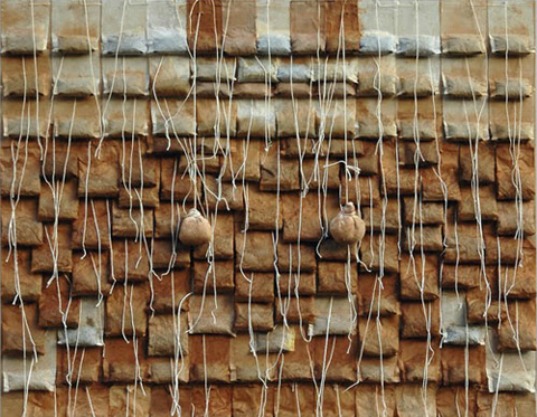Rio Wren Portland, USA
I was aware the other day how many times my daughter was using tea bags for preparing her surfaces for painting on as part of her GCSE art coursework. I am often helping my her by experimenting with different types of tea to see what colours she can get for her art surfaces. I started thinking about the other uses of tea leaves as a means to stain and colour papers and fabrics, and then I also wondered what other uses tea bags had been used as a way of creatively recycling.
Looking up tea on Wikipedia is says "Tea originated in southwestern China, where it was used as a medicinal drink. It was popularized as a recreational drink during the Chinese Tang dynasty, and tea drinking spread to other East Asian countries. Portuguese priests and merchants introduced it to the West during the 16th century. During the 17th century, drinking tea became fashionable among Britons, who started large-scale production and commercialization of the plant in India to bypass a Chinese monopoly at that time
The phrase herbal tea usually refers to infusions of fruit or herbs made without the tea plant, such as steeps of rosehip, chamomile, or rooibos. These are also known as tisanes or herbal infusions to distinguish them from "tea" as it is commonly construed.
So the fact that we can obtain some stunning colour palettes from using tea leaves, is one thing, but how about reusing the teabag itself to creatively recycle?
You can see from the image above (Source), that depending on the type of tealeaves and the strength of the brew, you can obtain different colours.
Twice boiled and tumeric dyed used and recycled tea bags, pressed flowers, thread, embroidery thread, machine and hand stitching.
Wewer Keohane, Kimono of teabags
Teabag tablecloth
1,400 tea bags, tea paper, bra parts, tea stained linen, leather for the bustle
Neenah Maier Tea Bag Dress
Source: Notes written on tea bags about Tea
Dried tea bag curtain
Source http://www.armenrotch.com
Source recycled tea bags, acrylic primer
Source: Tea bag dress
15 ways to reuse teabags
from
In Your Home
1. Clean Windows and Mirrors: Replace glass cleaners by pouring brewed, cooled tea into a spray bottle, or dampen a soft cloth with tea then wipe away fingerprints and dirt and dry.
2. Rid Your Refrigerator of Odors: Move over baking soda, keeping used tea bags in a bowl in your refrigerator will absorb odors.
3. Remove Grease and Residue from Pots and Pans: The tannic acid of tea will break down grease and leftover food residue stuck on your pots and pans. Put a cup or so of water and a used tea bag into your pans and let them soak. You may want to use multiple tea bags if the scum is really caked on.
4. Add Flavor to Rice: Toss used jasmine or mint flavored tea bags into boiling water to add extra flavor to your rice and other grains.
5. Meat Tenderizer: Never dry out your poultry again by adding water and a brewed tea bag into the pan during baking. Tea is an all-natural meat tenderizer.
6. Wash Away Odors from Your Hands: Rinse your hands with water and a brewed tea bag to remove odors of onions, garlic, fish and other foods.
7. Shine Dark Leather Shoes: Shine dark leather shoes by rubbing a wet tea bag in circular motion on the exterior then wipe dry.
8. Dye Fabric: Use black tea and few other household items to create a unique design on fabrics. Here’s how to make your own tea dye!
Gardening
9. Composting: Throw a few cups of brewed, ground tea or biodegradable tea bags onto your compost heap to speed up the decomposition process and create acid-rich soil.
10. Fertilize Plant Soil: Tear open your tea bags and disperse the contents over plants’ soil. Roses and ferns especially thrive from the acid-rich tannins in tea. You also can bring unhealthy plants back to life by watering them with twice-brewed tea. A useful tip to consider is to line the drainage hole at the bottom of planters with old tea bags. This will help your plants retain water and keep nutrients inside the soil.
Beauty and Health
11. Calm Itchy Skin: Soothe irritated skin caused by bug bites or poison ivy with a dampened, cool tea bag. This will reduce inflammation and promote healing.
12. Wake Up Tired Eyes: Place cooled tea bags, particularly chamomile, on tired eyes to lessen puffiness and feel rejuvenated.
13. Mouth Health: The antibacterial properties of tea can aid in drawing out infections linked to tooth aches, fever blisters, canker sores and other mouth-related illnesses. Warm up the tea bag and place it on the sore area for best results
14. Rehydrate Your Skin: Add a few tea bags and/or essential oils into a soaking basin with warm water to soothe tired feet. Soak for 20-30 minutes for softer skin.
15. Facial: Give yourself a spa-like facial by repeating the steps above, but holding your head above the basin and covering with a towel. The tannins will help to tighten your pores and reduce puffiness.
What other ways do you repurpose ground tea and/or tea bags? If you think I’ve missed any tips, leave me a note in the comment section. I’d love to hear from you.
























Great article. I learned lot of information. Thanks for sharing.
ReplyDeleteNon woven bag making machine price